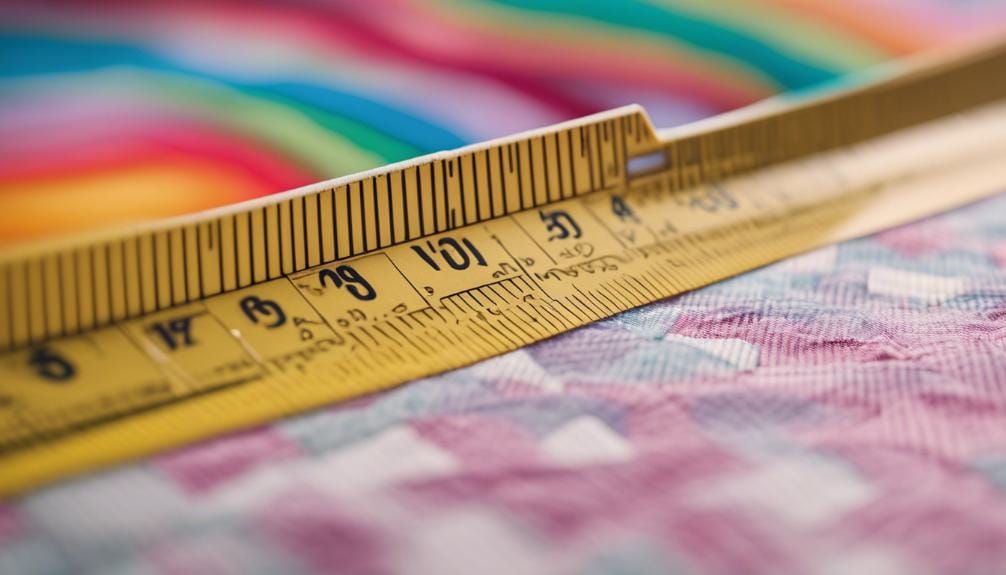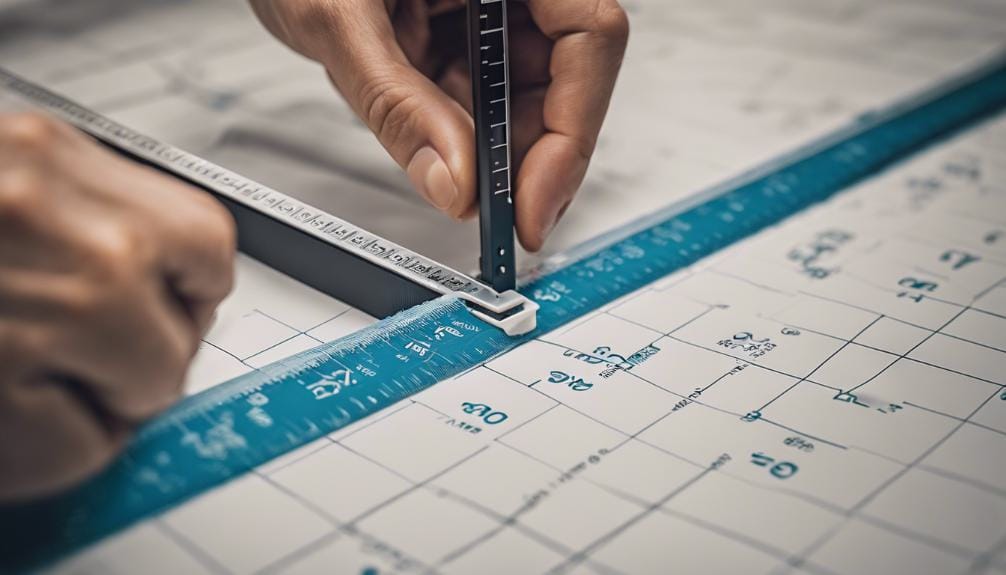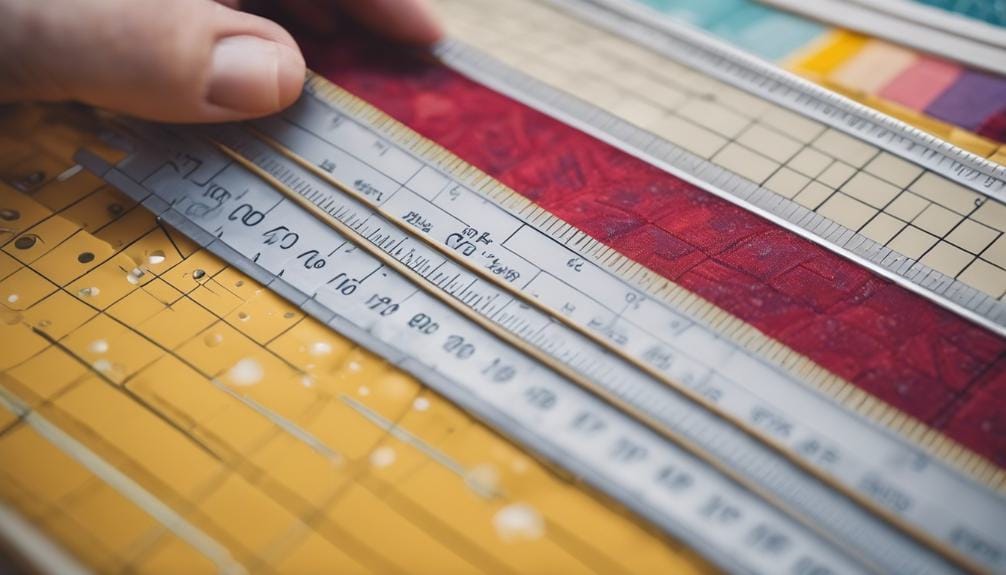How to Keep Quilting Rulers From Slipping? Practical Solutions Explored
When it comes to keeping your quilting rulers from slipping, the struggle can be real, but fear not, there are practical solutions to this common nuisance.
Imagine a world where your rulers stay firmly in place without the need for constant readjustment. By exploring various grip adjustments, adhesive grips, and non-slip alternatives, you can significantly enhance your quilting experience.
Stay tuned to discover the key to ruler stability and say goodbye to frustrating slippage during your next quilting project.
Key Takeaways
- Use adhesive grips like Template Grips or Dritz Slip N Grips for stable ruler placement.
- Explore non-slip solutions such as Creative Grids rulers to prevent ruler slipping during quilting.
- Experiment with different grip techniques like spreading fingers open and utilizing ruler handles for accuracy.
- Enhance stability by using 5-8 pound hand weights or suction cup handles combined with grip tape.
Adjust Your Grip
When quilting, ensure your ruler stays in place by adjusting your grip with strategic finger placements for stability and precision. To keep the ruler from slipping on the fabric, it’s crucial to use your fingers effectively. Place the ruler on the fabric with your hand palm down, and spread your fingers open to create a stable base. Use your pinky finger to hook over the outside edge of the ruler. This anchoring technique helps prevent any unwanted movement while you quilt. Additionally, consider utilizing your ring finger for extra support and stability when cutting through layers of fabric.
Experiment with different hand placements and grips to determine what works best for you in preventing ruler slipping. By adjusting your grip and using your fingers strategically, you can enhance the accuracy and efficiency of your quilting process. Remember, the key is to create a firm and secure connection between your hand, fingers, and the ruler. This not only prevents slipping but also allows you to focus on the precision of your cuts without any distractions. Mastering the art of adjusting your grip will significantly improve the quality of your quilting projects.
Add Adhesive Grips

Consider enhancing the stability of your quilting ruler by applying adhesive grips to the back for a non-slip surface. Adhesive grips like clear first aid tape or specific ruler grips can be attached to prevent rulers from slipping during your quilting projects. Here are some tips to help you effectively use adhesive grips:
- Choose Quality Grips: Invest in quality grips like Template Grips or Dritz Slip N Grips for optimal ruler stability. These grips are designed to provide a secure non-slip surface, making your quilting experience smoother and more precise.
- Opt for Clear Tape: Clear tape is a great option as it allows you to see the fabric through the ruler while still offering the stability you need. This transparency ensures that you can align the ruler accurately without any obstructions.
- Visit Quilt Stores: Explore your local quilt stores or online retailers to find a variety of clear tapes and ruler grips. Different brands offer unique features, so you can choose the one that best suits your needs. Trying out different options can help you discover the most effective adhesive grips for your quilting projects.
Use a Hand Weight

To enhance the stability of your quilting ruler further, utilizing a hand weight can prevent slipping and ensure precise cuts during your quilting projects. Placing a 5-8 pound hand weight on the far side of the ruler helps to secure it in place, preventing any unwanted movement while cutting fabric. If you don’t have a hand weight, you can use substitutes like canned food or a gallon of water to achieve a similar effect. Just ensure that whatever object you use is clean to avoid transferring any dirt onto your fabric.
Here is a table summarizing the key points about using a hand weight:
| Key Points | Details |
|---|---|
| Weight Recommendation | Use a 5-8 pound hand weight for optimal stability. |
| Alternative Substitutes | If you don’t have a hand weight, canned food or a gallon of water can be used. |
| Cleanliness | Ensure the weight is clean before placing it on the cutting surface to avoid fabric stains. |
Using a hand weight is a simple and cost-effective method to keep your ruler steady, ensuring accurate cuts every time without the need for expensive grips. It’s a practical solution for maintaining stability during quilting projects.
Use a Ruler Handle

Looking to enhance the stability of your quilting ruler and prevent slipping during your projects? Using a ruler handle can provide the extra grip you need to keep your ruler in place for accurate cuts. Here’s how you can make the most of ruler handles:
- Choose a Ruler Handle with Suction Cups: Opt for a ruler handle that comes with suction cups, as these can effectively grip onto your quilting rulers and prevent them from moving around while you work on your quilting projects.
- Combine with Grip Tape for Enhanced Stability: If you find that the suction cups alone aren’t providing enough grip, consider combining your ruler handle with grip tape. This combination can offer additional security, especially if you struggle with maintaining a firm hold on the ruler.
- Easy to Find and Use: Ruler handles are readily available at craft stores or online quilting retailers. They’re simple to attach to your quilting ruler and can make a significant difference in the accuracy of your cuts. Whether you’re a beginner or experienced quilter, using a ruler handle can ensure that your quilting projects turn out just the way you envisioned them.
Purchase Non-Slip Rulers

When seeking to enhance your quilting precision and stability, investing in non-slip rulers like Creative Grids can significantly elevate your cutting experience. Creative Grids rulers are designed with a special backing that prevents slipping when cutting, ensuring that your fabric stays in place for more accurate cuts. These rulers come in various sizes and shapes, such as 6.5 x 24.5 and 6.5 square rulers, offering versatility for different projects.
Accuracy is key in quilting, and the non-slip feature of Creative Grids rulers makes them a reliable choice for keeping your ruler steady while you work. The rulers are especially beneficial for small squares or intricate patterns where precision is crucial. Transitioning to non-slip rulers gradually can improve cutting accuracy and stability over time, making your quilting experience more enjoyable.
To further enhance the non-slip properties of your Creative Grids ruler, you can also consider adding sandpaper dots to the back of the ruler for extra grip. By investing in non-slip rulers, you not only ensure a stable cutting surface but also elevate the overall quilting experience by enabling precise cuts and smooth workflow.
Frequently Asked Questions
How Do I Keep My Quilting Ruler From Sliding?
To keep your quilting ruler from sliding, try using adhesive solutions like clear dots or Invisigrip, adjust your grip technique by anchoring the ruler, and consider using hand weights or non-slip rulers for added stability.
What Is the Best Way to Store Quilting Rulers?
To store quilting rulers effectively, use a dedicated rack or pegboard for vertical storage. Keep them in a cool, dry place away from sunlight and use protective sleeves. Label rulers for easy identification.
How Do You Free Motion Quilt With Rulers?
To free motion quilt with rulers, position ruler securely on fabric, ensuring ruler foot is in contact. Hold ruler firmly with one hand while guiding fabric with the other. Practice controlling speed and movement for precise stitching.
What Is the Best Ruler for Quilting?
For quilting, the best ruler is Creative Grids due to its non-slip stability and accuracy. It’s highly recommended. Consider Fabric Grips, Gypsy Gripper, Harbor Freight tools, or InvisiGrip for extra hold. These options enhance precision in your projects.
Conclusion
In conclusion, keeping your quilting rulers from slipping can greatly improve the accuracy and efficiency of your quilting projects.
By adjusting your grip, adding adhesive grips, using a hand weight, utilizing a ruler handle, or investing in non-slip rulers, you can ensure stability and precision while quilting.
Experiment with different methods to find what works best for you and enjoy a smoother quilting experience.
Happy quilting!



